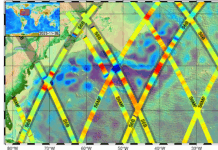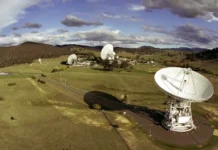The Curiosity Rover’s New Year’s Adventure on Mars
As the calendar turns to a new year on Earth, the Curiosity Rover is also marking a fresh start on Mars. Currently, Curiosity is navigating through sols 4416 to 4417, which are Martian days, and the rover is experiencing a whole new season filled with fascinating celestial phenomena. This period is particularly notable for the appearance of clouds, which are a rare and beautiful sight on the Martian landscape.
The Curiosity Rover, part of NASA’s Mars Science Laboratory mission, captured a stunning image of noctilucent clouds on sol 4401, which corresponds to December 23, 2024, in Earth time. The image, taken with the rover’s Right Navigation Camera, shows an otherworldly view of the Martian sky, where clouds glow luminously against a gray backdrop. These noctilucent clouds, which means “night shining,” are visible during twilight when the sun has set but still illuminates the clouds from below the horizon.
The recent Earth planning date for the mission was January 6, 2025. After an intense schedule over the holidays, the team has now transitioned back to a standard two-sol plan. Although the rover’s drive didn’t reach its intended destination, it remains in an optimal position to conduct contact science. The focus is on two interesting targets named “Snow Creek” and “Winter Creek.”
In addition to these, Curiosity’s remote science activities are in full swing. The ChemCam (Chemistry and Camera complex), which uses a technique called LIBS (Laser-Induced Breakdown Spectroscopy), is examining two targets, “Grapevine” and “Skull Rock.” This instrument helps scientists understand the composition of Martian rocks and soil by analyzing the light emitted from materials that are vaporized by a laser.
The rover is also capturing long-distance images of geological features such as Texoli and Wilkerson buttes, as well as Gould Mesa. The Mastcam, another key instrument on Curiosity, is taking detailed images of various nearby and distant features, including “Red Box,” “Point Mugu,” “Stone Canyon,” “Pine Cove,” and “Hummingbird Sage.” These observations are crucial for examining the different structures and compositions of Martian bedrock.
As Curiosity continues its mission, the team is also paying close attention to the Martian atmosphere. This includes conducting surveys for dust devils, which are small whirlwinds that can lift dust from the planet’s surface. However, the main highlight for many team members is the cloud imaging, which is providing spectacular views of the Martian sky.
Interestingly, while the Earth is just beginning 2025, Mars is also at the start of a new year. A Martian year commences at the northern vernal equinox, which marks the beginning of autumn in the southern hemisphere where Curiosity is located. The current Martian year, year 38, began on November 12. We are now about one-third of the way through autumn on Mars, a season known for its cloud formations. These clouds tend to appear near sunset, creating a dramatic and visually stunning spectacle.
These clouds are particularly captivating because, despite the sun having set in Gale Crater, they are high enough in the atmosphere to be illuminated from below the horizon. This phenomenon is akin to the twilight clouds observed on Earth. Mars year 38 is the fourth year that Curiosity has captured these mesmerizing twilight clouds, and the images from the Navcam (Navigation Camera) suggest that this year will be another remarkable one for cloud observations.
For those interested in exploring more about the Curiosity Rover and its mission, there are several resources available that provide insights into its journey and scientific endeavors. The mission’s homepage offers an overview, a location map, and regular updates. Additionally, the Science section delves into the rover’s instruments, scientific highlights, and exploration goals.
In terms of multimedia, the mission provides a wealth of images, including raw images from the rover, videos, and audio recordings. These resources allow the public to experience Mars through the eyes and instruments of Curiosity. For those fascinated by Mars, there is a dedicated section on Mars missions, which includes the Mars Sample Return mission, the Mars Perseverance Rover, and other missions like MAVEN and the Mars Reconnaissance Orbiter.
The Curiosity Rover’s mission is part of a broader effort to explore our solar system, with information available on planets such as Mercury, Venus, Earth, and others, as well as celestial objects like asteroids, comets, and the Kuiper Belt.
As we continue to follow Curiosity’s journey on Mars, we are reminded of the incredible achievements of space exploration and the wealth of knowledge it brings. The rover’s ability to capture and transmit data from a distant planet is a testament to human ingenuity and the relentless pursuit of discovery.
For more in-depth information and to stay updated on the Curiosity Rover’s mission, you can explore various NASA resources and blogs. These platforms provide a comprehensive look at the ongoing efforts to understand Mars and its potential for past or present life.
In summary, the Curiosity Rover’s exploration of Mars offers a unique glimpse into the dynamic and ever-changing environment of the Red Planet. As it documents and analyzes the Martian landscape, we gain valuable insights into the planet’s geological history and atmospheric conditions. The mission continues to inspire scientists and space enthusiasts alike, highlighting the importance of exploration and discovery in expanding our understanding of the universe.
For more Information, Refer to this article.


































